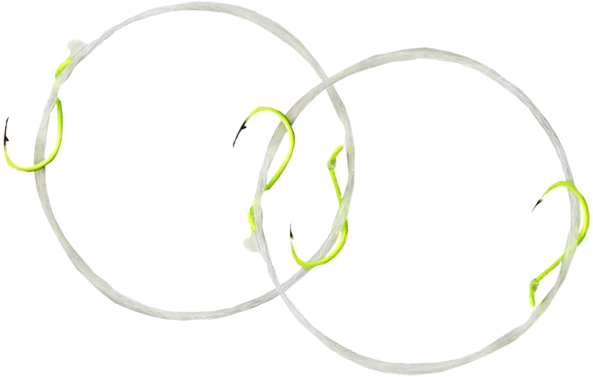Salmon/Steelhead

Characteristics

Salmon can be identified by their gum line structure and lower jaw.
Males: Hump in front of the dorsal fin, sharp teeth, elongated snout.
Females: Change colour but keep their body shape.
Canada has seven salmon species:
- Atlantic Salmon
- Chinook Salmon
- Chum Salmon
- Coho Salmon
- Pink Salmon
- Sockeye Salmon
- Steelhead (mature Rainbow Trout that migrates to the ocean)
Each species has unique traits but exhibits similar behaviours, making angling techniques interchangeable. When not spawning, they are silver, streamlined, and can grow large. They require heavy-duty gear as they are strong fighters.
Habitat

When they are battling the rougher rapids of some of these rivers and streams, they have been known to leap out of the water in a stunning display, as their bodies turn a bright pink/orange during spawning season.
Ocean

When ocean fishing, it's crucial to rinse your gear with fresh water after use due to saltwater corrosion. Use brightly coloured lures, and even saltwater-specific tackle should be rinsed. Ensure your fishing line is suitable for the size of fish you’re targeting; consider using a lighter leader combined with shorter, heavier monofilament for easier casting.
Beach

For this approach to be most effective, you’ll want to look for tidal currents and shallow sloughs where fish are likely to be present.
When fishing from the surf, your rod should be on the longer side to allow you greater reach. If you’re beach fishing in the ocean, you’ll want to double check your gear is corrosive-resistant because salt water can be harsher on equipment.
Bar Fishing

This technique requires a moderately elaborate set-up, with a leader line secured to a main line through a bar rig.
The mainline is suspended vertically through the use of a terminal weight, while the leader line extends horizontally with a Spin-N-Glo secured a few inches before the hook at the end of your leader line. The length of your leader line can be adjusted depending on how elevated you want your Spin-N-Glo in the water column.
River Spoons
The metal spoon lure dates back to the 1840’s, evidenced by its simple design. Its concave and oblong shape catches water, making the lure wobble as it progresses on its path, mimicking the movement of fish, which is why they are especially effective in rivers, where a water current is encouraging movement in the lure.
The material of the lure is also slightly reflective, attracting predators. The majority of the attraction of this lure is produced visually and it works best in somewhat clear water conditions. They are most commonly used for larger catches.

River Drift Fishing/Floating Fishing

This tactic is used by anglers fishing in streams or rivers with a moving current.
The float will help your bait stay just above the bottom surface (aka the strike zone), so you’ll want to measure your line properly to ensure your bait doesn’t drag along the bottom. Half-way down your line, you’ll secure a weight, which will help keep your line vertical as it moves along with the flowing water.
If your float isn’t sitting up perfectly on the surface of the water, you likely need to adjust your weight. If the floater points forward (in the direction that the water is moving), then you should reduce the weight. If it’s pointing backwards, in the opposite direction, you need a heavier weight. There is usually a line on the float which indicates where it should sit in relation to the surface of the water.
Rigging

Rigging involves creating a reliable hooking apparatus using various components such as a main line, leader line, weights, hooks, rod, reel, and bait. This customizable setup helps optimize fishing based on desired results. The weight keeps the bait at the fish's level, while the recommended leader line length varies with water clarity and fishing pressure—anglers often prefer 3-foot snells in murky waters and 8-foot snells in clear waters."